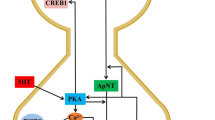Abstract
Effect of nifedipine on inhibitory postsynaptic currents (IPSC) was studied in cultured hippocampal neurons. Nifedipine, if used in low concentrations, caused no essential changes in the IPSC amplitude. If used in high concentrations (50 or 100 μM), this calcium channel blocker reduced the IPSC amplitude, on the average, by 35 and 42%, respectively. The calcium current component sensitive to nifedipine at high concentrations was found to be insensitive to the agents, which block calcium channels of N- and P/Q types. It is concluded that the L-type calcium channels sensitive to nifedipine in low concentrations are absent in the presynaptic membrane of inhibitory synapses, whereas the only component of calcium current sensitive to this blocking agent in a high concentration, as well as the ω-CTx-GVIA- and ω-Aga-IVA-sensitive components of this current, participate in the transmission of inhibitory synaptic influences on the neurons studied.
Similar content being viewed by others
References
B. Katz,The Release of Neural transmitter Substances, Univ. Press, Liverpool (1969).
J. L. Luebke, K. Dunlap, and T. J. Turner, “Multiple calcium channel types control glutamatergic synaptic transmission in the hippocampus,”Neuron,11, No. 5, 895–902 (1993).
D. Wheeler, A. Randall, and R. Tsien, “Roles of N-type and Q-type Ca-channels in supporting hippocampal synaptic transmission,”Science,264, 107–111 (1994).
F. W. Pfrieger, N. S. Veselovsky, K. Gottmann, and H. D. Lux, “Pharmacological characterization of calcium currents and synaptic transmission between thalamic neuronsin vitro,”J. Neurosci.,12, No. 11, 4347–4357 (1992).
E. V. Isaeva, D. V. Vasil’yev, S. A. Fedulova, and N. S. Veselovskii, “Evoked and spontaneous excitatory postsynaptic currents in cultured hippocampal neurons,”Neirofiziologiya/Neurophysiology,29, Nos. 4/5, 369 (1997).
O. V. Isaeva, S. A. Fedulova, and N. S. Veselovskii, “Voltage-dependent calcium channels in cultured hippocampal neurons,”Neirofiziologiya/Neurophysiology,30, 361–365 (1998).
H. Taschenberger and R. Grantin, “Several types of Ca2+ channels mediate glutamatergic synaptic responses to activation of single Thy-1-immunolabelled rat retinal ganglion neurons,”J. Neurosci.,15, Mar., 2240–2254 (1995).
M. Waard, C. Gurnett, and K. Campbell, “Structural and functional diversity of voltage-activated calcium channels,”Ion Channels,4, 41–87 (1996).
P. Dutar, O. Rascol, and Y. Lamour, “Omega-conotoxin GVIA blocks synaptic transmission in theCA1 field of the hippocampus,”Eur. J. Pharmacol.,174, Nos. 2/3, 261–266 (1989).
L. G. Wu and P. Saggau, “Presynaptic calcium is increased during normal synaptic transmission and paired-pulse facilitation, but not in long-term potentiation in areaCA1 of hippocampus,”J. Neurosci.,14, No. 2, 645–654 (1994).
Author information
Authors and Affiliations
Rights and permissions
About this article
Cite this article
Isaeva, E.V. Effect of nifedipine in high concentrations on inhibitory synaptic transmission. Neurophysiology 31, 53–55 (1999). https://doi.org/10.1007/BF02515015
Issue Date:
DOI: https://doi.org/10.1007/BF02515015




